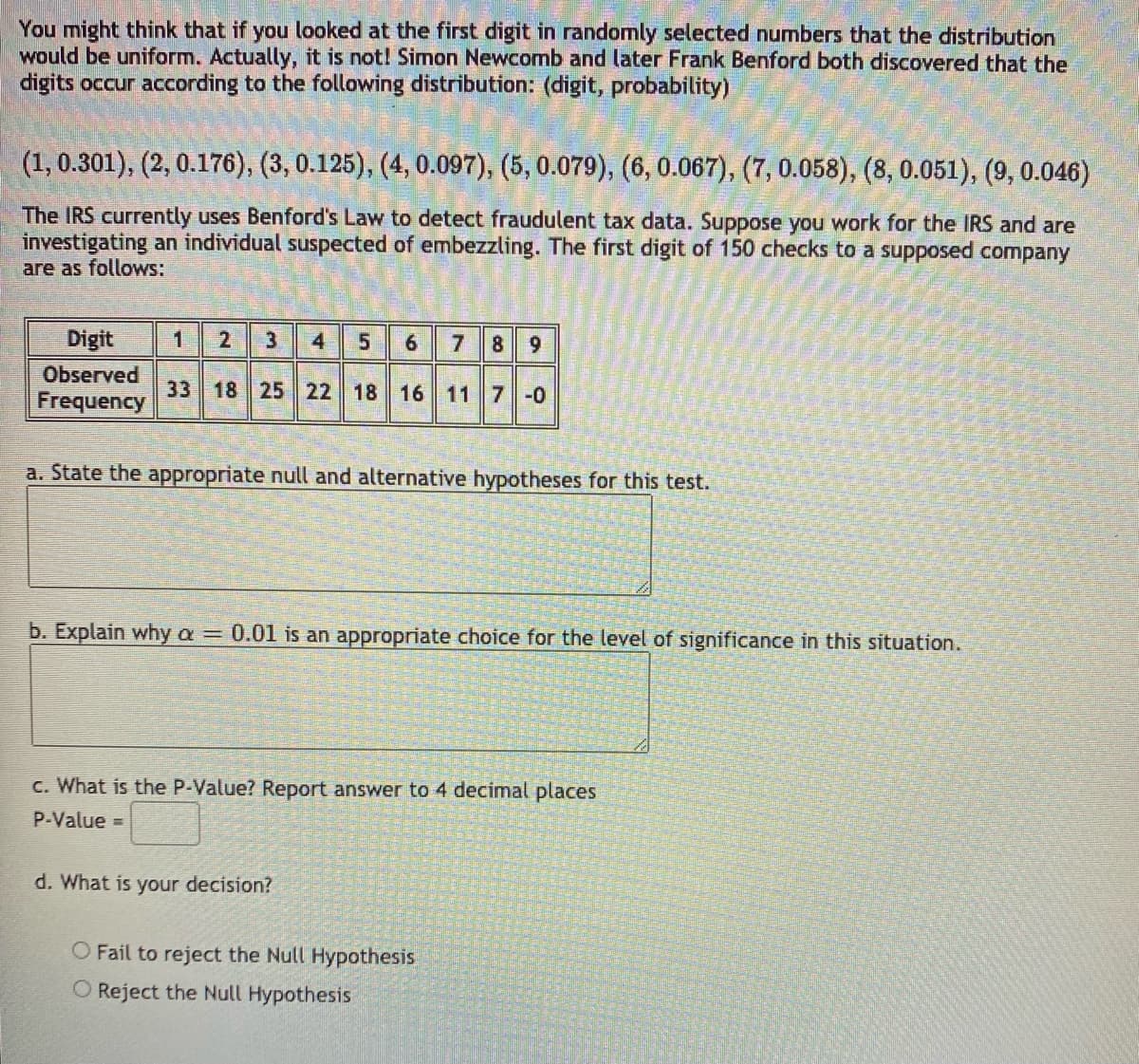You might think that if you looked at the first digit in randomly selected numbers that the distribution would be uniform. Actually, it is not! Simon Newcomb and later Frank Benford both discovered that the digits occur according to the following distribution: (digit, probability) (1, 0.301), (2, 0.176), (3, 0.125), (4, 0.097), (5, 0.079), (6, 0.067), (7, 0.058), (8, 0.051), (9, 0.046) The IRS currently uses Benford's Law to detect fraudulent tax data. Suppose you work for the IRS and are investigating an individual suspected of embezzling. The first digit of 150 checks to a supposed company are as follows: Digit 1 2 4 6 78 9 Observed 33 18 25 22 18 16 11 7 -0 Frequency a. State the appropriate null and alternative hypotheses for this test. b. Explain why a = 0.01 is an appropriate choice for the level of significance in this situation. c. What is the P-Value? Report answer to 4 decimal places P-Value = d. What is your decision? O Fail to reject the Null Hypothesis O Reject the Null Hypothesis
You might think that if you looked at the first digit in randomly selected numbers that the distribution would be uniform. Actually, it is not! Simon Newcomb and later Frank Benford both discovered that the digits occur according to the following distribution: (digit, probability) (1, 0.301), (2, 0.176), (3, 0.125), (4, 0.097), (5, 0.079), (6, 0.067), (7, 0.058), (8, 0.051), (9, 0.046) The IRS currently uses Benford's Law to detect fraudulent tax data. Suppose you work for the IRS and are investigating an individual suspected of embezzling. The first digit of 150 checks to a supposed company are as follows: Digit 1 2 4 6 78 9 Observed 33 18 25 22 18 16 11 7 -0 Frequency a. State the appropriate null and alternative hypotheses for this test. b. Explain why a = 0.01 is an appropriate choice for the level of significance in this situation. c. What is the P-Value? Report answer to 4 decimal places P-Value = d. What is your decision? O Fail to reject the Null Hypothesis O Reject the Null Hypothesis
Glencoe Algebra 1, Student Edition, 9780079039897, 0079039898, 2018
18th Edition
ISBN:9780079039897
Author:Carter
Publisher:Carter
Chapter10: Statistics
Section10.4: Distributions Of Data
Problem 19PFA
Related questions
Question

Transcribed Image Text:e. Write a statement to the law enforcement officials that will use it to decide whether to pursue the case
further or not. Structure your essay as follows:
Explain why a Goodness of Fit test should be applied in this situation.
Using your answers to parts c and d, make a conclusion about whether the individual is likely to have
embezzled, and then tell the law enforcement officials whether they should pursue the case or not.

Transcribed Image Text:You might think that if you looked at the first digit in randomly selected numbers that the distribution
would be uniform. Actually, it is not! Simon Newcomb and later Frank Benford both discovered that the
digits occur according to the following distribution: (digit, probability)
(1, 0.301), (2, 0.176), (3, 0.125), (4, 0.097), (5, 0.079), (6, 0.067), (7, 0.058), (8, 0.051), (9, 0.046)
The IRS currently uses Benford's Law to detect fraudulent tax data. Suppose you work for the IRS and are
investigating an individual suspected of embezzling. The first digit of 150 checks to a supposed company
are as follows:
Digit
2
4
7
Observed
33 18 25 22 18 16 11 7-0
Frequency
a. State the appropriate null and alternative hypotheses for this test.
b. Explain why a = 0.01 is an appropriate choice for the level of significance in this situation.
c. What is the P-Value? Report answer to 4 decimal places
P-Value =
d. What is your decision?
O Fail to reject the Null Hypothesis
O Reject the Null Hypothesis
Expert Solution
This question has been solved!
Explore an expertly crafted, step-by-step solution for a thorough understanding of key concepts.
This is a popular solution!
Trending now
This is a popular solution!
Step by step
Solved in 6 steps with 4 images

Knowledge Booster
Learn more about
Need a deep-dive on the concept behind this application? Look no further. Learn more about this topic, statistics and related others by exploring similar questions and additional content below.Recommended textbooks for you

Glencoe Algebra 1, Student Edition, 9780079039897…
Algebra
ISBN:
9780079039897
Author:
Carter
Publisher:
McGraw Hill


Glencoe Algebra 1, Student Edition, 9780079039897…
Algebra
ISBN:
9780079039897
Author:
Carter
Publisher:
McGraw Hill
